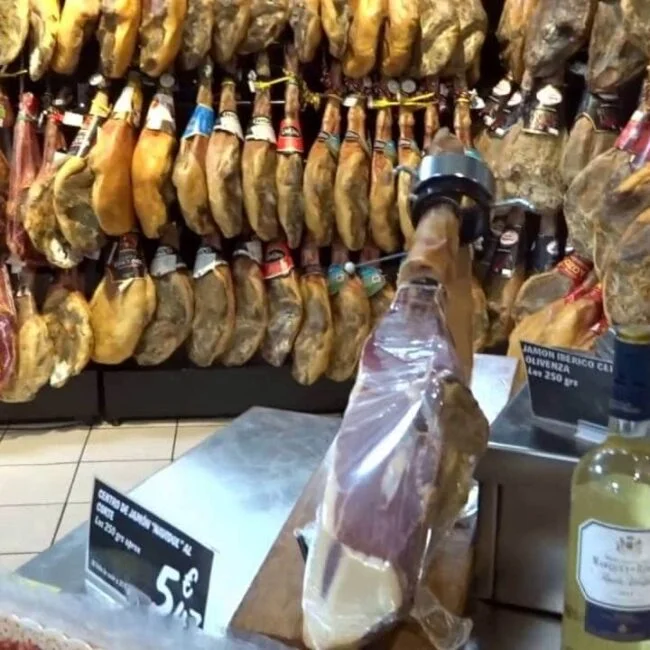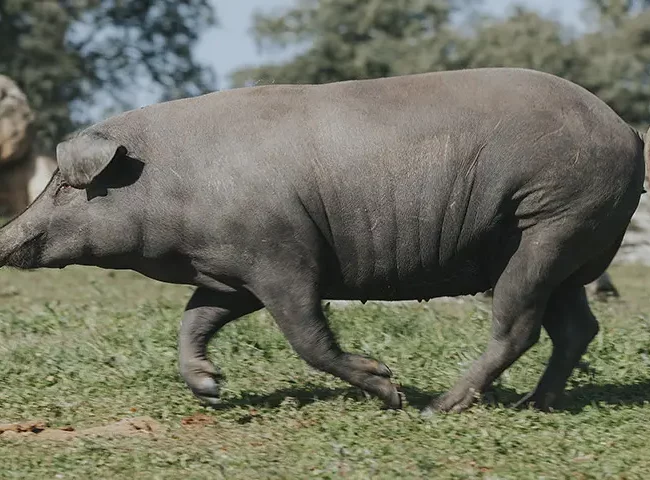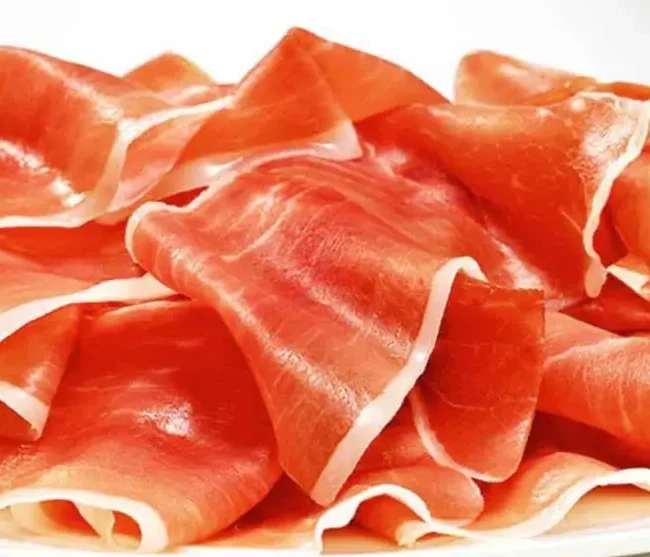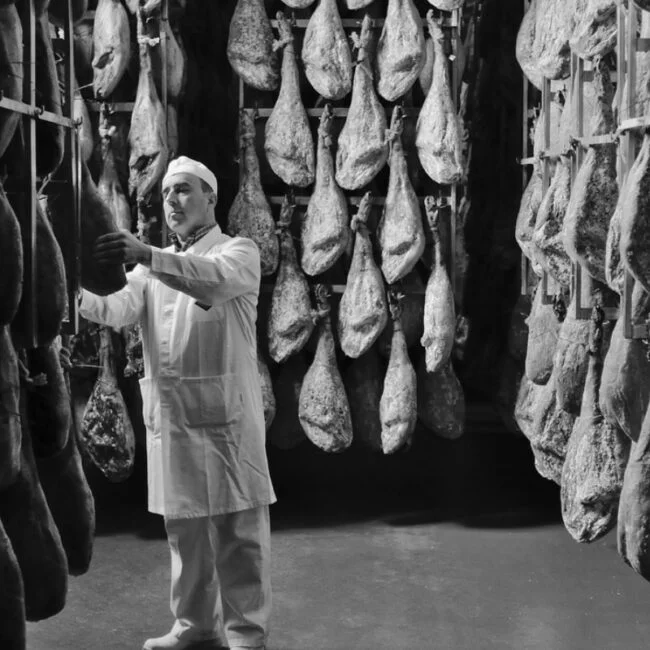Eating Ham in ANTEQUERA
Earlier in this website we touched briefly on the two types of Spanish ham: Serrano and Iberico.
This section looks at the background to the Spanish ham offering, in a little more depth.
Like the olive, and goats milk cheese, ham is fundamental to the Spanish diet.
The Anomaly of Spanish Ham
Unlike the olive, and goats milk cheese, ham is both a staple and a luxury.
Serrano ham is commonly enjoyed at breakfast, with a mollete and olive oil for example. It is sometimes served thinly sliced, or cubed, in salads. It is the ham of choice for fragmenting on top of the Antequeran porra. So too, it is used for flavouring stocks and soups.
Vacuum packed sliced Serrano ham is readily available, and easily affordable, in supermakets.
Iberian ham, on the other hand, is regarded as something more special. It’s taste, texture, and presentation on a plate, is quite different to Serrano ham.
A leg of Iberian ham can cost several times that of a haunch of Serrano ham, depending on the grade.
The reason primarily, is that the pig of source is different. The areas in Spain for achieving the finished product are different too, though the maturation methods are similar.

The Iberian Pig

The Iberian pig (cerdo iberico), is black in colour, not white.
It is a semi domesticated breed, which exists largely in the light forests (dehesa) of Extremedura, and to a much lesser extent in parts of Castile, and north western Andalusia.
This pig grazes on grasses, herbs, and particularly foraged roots. They also feed on olives, which adds flavour to the pig meat. From an early age it rapidly develops fatty tissue, which permeates it’s whole body, and leads to the fine fat marbelling that is a fundamental characteristic of jamon iberico.
In the summer, when the land becomes extremely arid, the pigs are fed grain.
However, the key to the diet of the cerdo iberico occurs in the autumn. The dehesa is largely populated with stone oak and cork trees, and in the autumn their acorns fall from the trees. The pigs now develop an amazing appetite, with an animal putting on 60 – 80 kilograms in a few months. This period of fattening is called montanera.
It is this diet of acorns, in the end cycle of the year, that gives the Iberian ham it’s aromatic taste.
Some Iberian pigs have black trotters, leading to the descriptor pata negra (black paw). Historically, the black trotter was considered a mark of good breeding.
In Antequera, you may see jamon iberico flagged on packaging as pata negra. They are one and the same though.
As an aside note, these remarkably stolid, and undemanding animals, make an ecological contribution to their forested home, as their grubbing for roots keeps the undergrowth down, and their manure fuels the continued growth of plants and trees.
Iberian Ham
The pigs are slaughtered in the winter. They will be aged 14 – 18 months, and weigh around 180 kilograms.
This is where the knowledge and skill to producing quality jamon iberico moves beyond the breed of pig and what it eats. The maturation process is critical.

Maturation
The ideal conditions for maturing ham are mountain situations where there is plenty of fresh air for drying the hams.
The most important centres for maturing the jamon iberico are all in western Spain.
Extramadura has the villages of Jerez de los Caballeros, Fregenal de la Sierra, and Oliva de la Frontera. Ham producing villages of Guijelo and Candelario are in southern Salamanca. In Andalusia well respected hams come from Jabugo, in the Sierra de Aracena, and a number of small producers in the Pedroches Valley of Cordoba.
Prior to the maturation process however, and following the slaughter, the animals are drawn of blood, and then salted. They remain in salt for around 14 days. The hams are then washed and kept in cool storerooms for up to six weeks (the ‘resting’ period). Here the meat dehydrates, giving the ham a denser consistency.
The maturation process really begins here.
The hams are suspended in drying halls (secaderos) within regulated amounts of the mountain fresh air supply.
As the temperatures get higher seasonally, the hams ‘sweat’, and lose weight, which accentuates their aromas.
Unlike Italian Parma ham, which is covered by lard in this process, Iberian ham is not, as it would affect the flavour. It is pure ham, waiting to be cured by the mountain air. In this respect, it is 100% natural.
Finally, they are hung in cooling cellars (bodegas), for up to 14 months.
A good Iberian ham may be matured in this way for 2 years, or sometimes, more.
The hams are tested for their quality before grading and marketing. The tester, or master of hams, (calador), inserts a small probe, made of bone, in various areas of the ham. He removes a fragment of the meat to test the aroma, as the indicator of whether the desired quality has been attained.

- Bellota – the highest grade, and most expensive. The pigs must be a minimum of 75% Iberian by breed. They have to have put on 40% of their live weight under free-range conditions, feeding exclusively on the acorns and vegetation of the dehesa.
- Recebo – ham from pigs which have been fed on a maximum of 30% grain during the final fattening process.
- Pienso – ham from pigs fattened exclusively on grain. Pienso ham may also be labelled as cebo or campo iberian ham.
Serrano Ham

Like jamon iberico, Serrano ham is mountain air cured.
The difference, is in the areas used for maturation of the ham haunches. Serrano ham is predominantly air cured in the mountain ranges of eastern Andalusia, notably the Sierra Nevada. This sierra is Spain’s highest, at 1700 meters (5575 feet).
Matured hams of the best reputation come from the town of Trevelez, in this snowy sierra.
The Andalusian poet Pedro de Alarcon once described the drying houses as secaderos a la ventilacion de la nieve (dryers of snow ventilation).
Two further differences between Serrano ham and Iberian ham is obviously in the pig source, and the method of farming.
Serrano ham comes from a white pig, usually the Landrace breed, Duroc or Pietran, which are purposefully bred and industrially farmed for mass production of pork.
The scale of jamon serrano production is thus vastly greater than jamon iberico. It is reported to make up an astonishing 93% of all ham production in Spain.
White pigs are farmed in enclosed pig houses, and given a grain and cereal based diet. They normally live for no more than 8 months, and their weight might be 90 – 100 kilograms.
Due to their diet the body fat is not integrated into the meat. The fat content of the pig is around 25%. Unlike the marbelled meat of the Iberian ham, with sliced Serrano ham you will see the meat is pure pink, with the fat around the edges.
Maturation
Whilst, as mentioned above, the maturation process is similar to Iberian ham, the period of maturation is normally less.
The grading of Serrano hams are:
- De Bodega – cured between 10 and 12 months.
- Reserva – cured between 12 and 15 months.
- Gran Reserva – cured for longer than 15 months.
Conclusion
There is plenty more that could be interestingly added to the origins, and merits of Spain’s hams.
But, for now, in order to get this section published, here you have it.
Is there an anomaly in the culture of Spanish hams?
Spain produces some of the best, and most expensive hams in the world. A leg of bellota jamon iberico can cost 4.500 U.S. Dollars.
Ideally one needs an accompaniment to a slice of Serrano, be it only a chunk of oily bread. Whereas, it is sacrilegious to eat a piece of quality Iberian other than by itself.
Yet, both Serrano ham and Iberian ham offer a lovely eating experience.
So, yes, there is an anomaly. Yet, we are privileged to have it!
